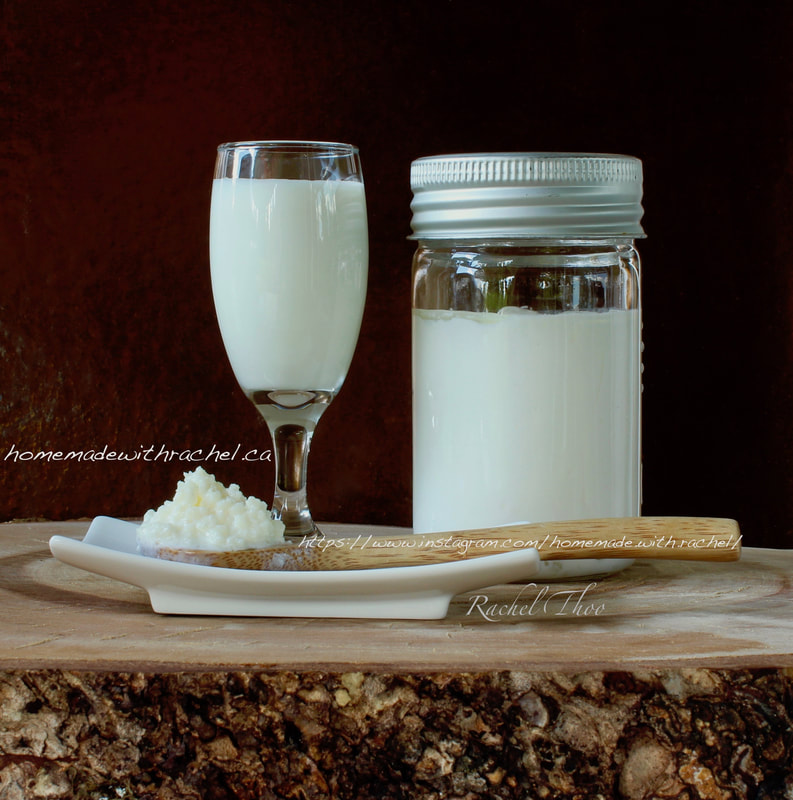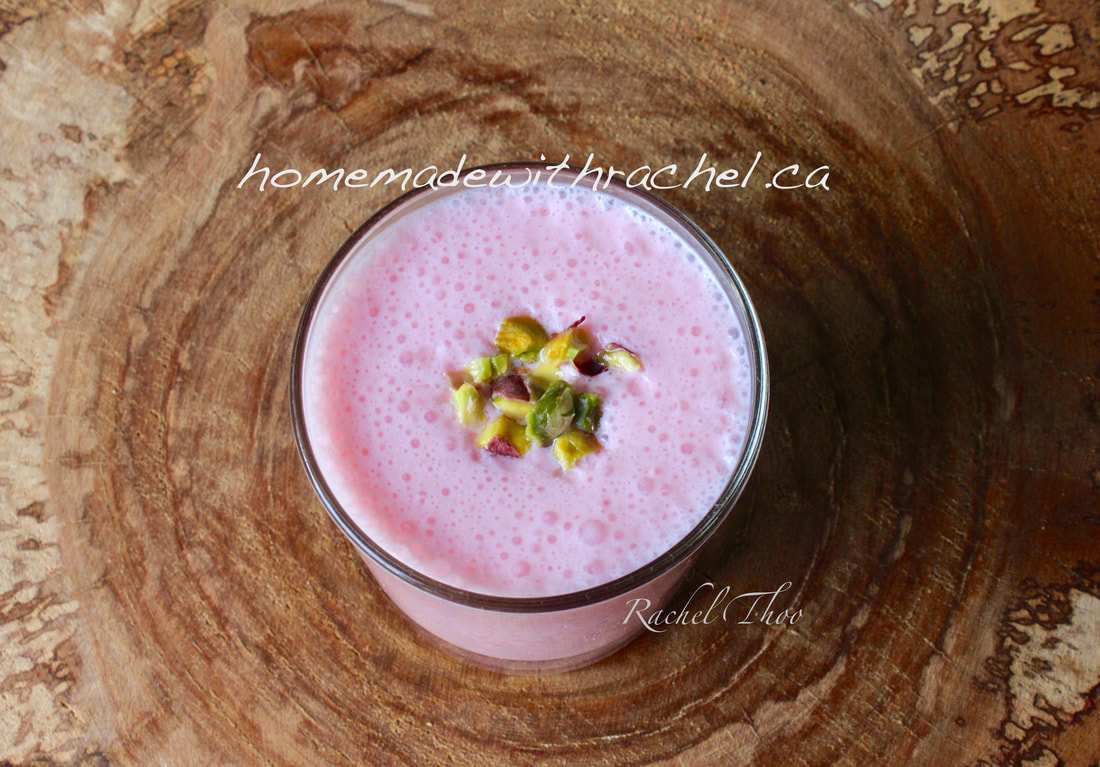|
In recent years, there has been a strong interest in beneficial fermented foods with natural occurring probiotics, such as milk kefir. Store bought milk kefir is usually pasteurized with most of the beneficial microbes destroyed during the process. This is to ensure uniformity and shelf life, but it also limits their good bacteria to a minimum amount. Traditionally homemade milk kefir contains billions of CFU (colony forming units), a spectrum of beneficial microbes, which is the whole point of eating probiotic foods. Can you spare 3-5 minutes a day? That is how long it would take to make milk kefir. It’s easy, and cost effective, and superior to store-bought. What is Milk Kefir? Milk Kefir is a drinkable fermented milk product with a slightly tart taste much like yogurt, and a creamy consistency. There are far more strains of microoganisms in kefir than that of yogurt, making it an excellent source of probiotics. It is pronounced ‘KAH – FEAR’. Milk kefir grains are a living organic culture made up of proteins, sugars, and fats. It is composed of living colonies of various yeasts and bacteria existing in a microbial symbiotic matrix. These microorganisms ferment the lactose in the milk over the course of a day, resulting in a tart and effervescent drink beneficial for its probiotic qualities and gut health. Health Benefits of Milk Kefir Milk kefir is a good source of Calcium, B12, Magnesium, Phosphorus, Riboflavin, and some vitamin D. It contains antibacterial properties to protect against infections, and boost your immune system. Kefir increases the absorption of calcium beneficial for bone health, and lowers the risk of osteoporosis. How Is Milk Kefir Made? Milk kefir is produced by inoculating milk with kefir starter culture called grains and fermented over time. The grains range in colour from pure white to yellowish white. White is the acceptable colour of healthy grains. Yellowish white is the outcome of leaving the grains in the same milk during fermentation for longer than the optimal 24-hour period. They may grow from the size of a rice grain to as large a clump as a cauliflower floret. After successive fermentations, kefir grains can divide into a new generation of grains, which have the same characteristics as the old ones. In short, they make babies and multiply when healthy! Traditionally, milk kefir is made using cow, ewe, goat, or buffalo milk. Raw – unpasteurized whole fat milk has been used with kefir where milk kefir originated somewhere in the Caucasus and Persia. These days, you have the choice of raw, pasteurized, organic or non-organic, full fat, reduced fat, homogenized or a mixture of such milk treatments. You can even use cream! Cow milk will produce a thick, smooth milk kefir, whereas goat milk will create a thinner finish. Sheep and buffalo milk is sweeter and contains more protein, resulting in a thicker, and creamier milk kefir. I highly recommend you use organic full–fat whole milk. The only kind of milk NOT recommended for milk kefir is ultra-high temperature treatment (UHT) milk. However, animal milk might be scarce, expensive, or not consumed due to dietary constraints, preferences, or religious customs. In this case, soy, coconut or almond ‘milk’ can be used in place of animal milk. If you choose to use non-animal milk, note that it is important you put kefir grains in animal milk every few days for a period of 24 hours. This process allows the grains to feed and rejuvenate. You may rinse it with a non-dairy ‘milk’ if you prefer not to consume the slightest bit of dairy. Do not rinse your milk kefir grains in water. Milk Kefir Recipe Ingredients 1 tsp/5 ml of milk kefir grain for every 1-3 cups of milk or 1 TBSP/15 ml of milk kefir grains per 1 quart/1 liter of milk or more * The ratio for grains to milk depends on the temperature of the room, the amount of time you would like it to ferment, etc. More grains mean less fermentation time. A warm room will also ferment the milk kefir quicker. Supplies needed:
Instructions
Milk kefir grains are available to purchase here. Milk Kefir is versatile. You can use it in place of yogurt in most recipes. You can make lassi, dips, ice-cream, labneh, etc. The possibilities are endless. Milk Kefir Hotel: Milk kefir grains can be stored in a "hotel" for a period of time when you are taking a break, or if you have too many grains. With a hotel, you are ensured a backup of milk kefir grains if anything should happen to your ferment. To keep extra grains, simply add enough milk to cover them; let the grains ferment for an hour or 2, and then transfer the jar to the fridge. I like to refresh my hotel milk kefir grains every 4-7 days. When you need a break of 2-3 weeks, add 2-4 cups of milk to 1-2 tsp of milk kefir grains, depending on how long your break period is. Let it sit for an hour at room temperature to get a head start on their feeding, and then refrigerate. Your grains need to be actively culturing for at least a month before putting them away to "sleep" in a hotel. It may take a couple of tries to "wake" them up when you resume your daily milk kefir fermentation with fresh milk. * If you need to rinse your milk kefir grains, rinse them in milk. DO NOT rinse them in water. This is a video I made to show how easy it is to make milk kefir! Follow me on: https://www.instagram.com/homemade.with.rachel/
Subscribe to my Youtube channel: https://www.youtube.com/channel/UCAFl_CDC5YmsJUqoC6j519Q
11 Comments
Sandra Davis
6/1/2020 03:21:52 pm
Hello
Reply
Rachel
6/2/2020 04:33:17 pm
Yes, I live 40 minutes south of North Bay, Ontario. Shipping is free and you can order from our shop site here: http://www.homemadewithrachel.ca/store/p30/Live_Organic_Milk_Kefir_Grains.html
Reply
Shannon
2/9/2021 09:18:20 pm
I just received milk kefir grains in the mail from you. The instructions say I should strain the existing milk from the grains and add new milk to them. But what do I do then - do I put the container in the refrigerator, or keep it out? Thanks for your help!
Reply
Rachel
2/11/2021 07:27:42 pm
Hi Shannon,
Reply
Nick
6/14/2021 08:49:10 pm
Hi Rachel,
Reply
Rachel
6/15/2021 02:48:07 pm
Hi Nick,
Reply
Carol
10/12/2021 03:51:59 pm
Hi Rachel,
Reply
Daliborka
4/15/2022 08:27:43 pm
Hi Rachel
Reply
Rachel
4/20/2022 12:58:31 pm
I, myself buy organic milk, and it sits in the fridge till I am ready to strain and ferment another batch of milk kefir. So, to answer your question, yes, absolutely ok to do so.
Reply
Dianne Fallon
6/13/2023 06:48:23 pm
My kefir has been very thick almost like feta with lots of whey. I assume this issue is due to overfermentation? I forced through a fine strainer and saved the remaining product left behind which I am hoping still has love grains in it? Not sure what to do now??
Reply
Rachel
6/16/2023 12:00:45 pm
Hi, Dianne,
Reply
Your comment will be posted after it is approved.
Leave a Reply. |
AuthorRachel conducts gardening, culinary and fermenting workshops/retreats at her home on 100 acres in Northern Ontario, Canada, where she lives in creative harmony with nature. Rachel’s mission is to ensure the wisdom of our ancestors is preserved for future generations. Archives
July 2020
Categories
All
Images ©2002-2023 Rachel Thoo |
Site powered by Weebly. Managed by Web Hosting Canada


 RSS Feed
RSS Feed